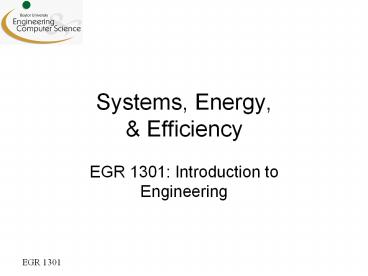Systems, Energy, - PowerPoint PPT Presentation
Title:
Systems, Energy,
Description:
Systems, Energy, & Efficiency EGR 1301: Introduction to Engineering – PowerPoint PPT presentation
Number of Views:152
Avg rating:3.0/5.0
Title: Systems, Energy,
1
Systems, Energy, Efficiency
- EGR 1301 Introduction to Engineering
2
Systems
- System
- A particular subset of the universe specified in
time and space by a boundary (Ch 17, p. 484)
System boundary
tinitial start time tfinal stop time
Source Professor Thomas
3
System Definition
- Rules the engineer must follow
- Once a system is specified, it cannot be changed
midway through a calculation. - The system boundary can be any shape, but it must
be a closed surface. It must also be closed (or
bounded) in time. - The system boundary can be rigid (defining a
volume of space) or it can be flexible (defining
an object).
4
Importance of System Definition
Source Foundations of Engineering, Holtzapple
Reece, 2003
5
Intensive vs. Extensive
- Extensive quantities
- Change with size of the system
- Intensive quantities
- Remain constant, regardless of size
Quantity Intensive Extensive
Volume
Mass
Density
Temperature
X
X
X
X
6
What is Energy?
- The capacity for doing work
- OR
- Unit of exchange (Ch 22, p. 572)
- Examples
- Electricity ? light or heat
- Chemical energy in gasoline ? torque in car or
heat - Natural gas ? electricity or hot water
Source Websters New Collegiate Dictionary
7
Units of Energy
Source Foundations of Engineering, Holtzapple
Reece, 2003
8
1st Law of Thermodynamics
- Law of Conservation of Energy
- Energy can neither be created nor destroyed
- Therefore, energy must be conserved
- Energy can only be transformed
- Work can be converted into another form of work
- Work can be converted into heat
- Need to keep track of, or account for, these
changes
9
Money Accounting
- Can account for the money in your bank
- Ex
- Start with 1000
- Pay you 500 for coming to class
- Spend 800 on new laptop
- How much do you have (i.e. final balance)?
Final balance Initial balance Deposits -
Withdrawals
Accumulation Net input
Final balance Initial balance Deposits -
Withdrawals
10
Energy Accounting
- For any system, the same relationship is true
Final energy Initial energy Input - Output
Accumulation Net input
State quantities Path quantities
System Boundary
Energy in/out (Path Quantities)
Accumulated Energy (State Quantities)
11
State Quantities
- Kinetic Energy
- Energy associated with motion
- Potential Energy
- Energy associated with position, either against a
field (e.g. gravity or electric field),
compressed spring, or stretched rubber band - Internal Energy
- Energy associated with atoms, such as
temperature, phase changes, or chemical reactions
12
Path Quantities
- Work
- Energy flow due to a driving force other than
temperature mechanical (shaft, hydraulic),
electrical, photonic (laser, solar PV) - Heat
- Energy flow due to temperature conduction,
blackbody radiation - Mass
- Energy flow due to mass crossing the boundary
fuel
13
Universal Accounting Equation
- Mathematical version of the accounting equation
- All have the form
Change in kinetic energy
Change in potential energy
Change in internal energy
Change Energy at tfinal - Energy at tinitial
14
Universal Accounting Equation
- Mathematical version of the accounting equation
- Heat and Mass have the form
Work input work done on the system from its
surroundings
Work output work done by the system to its
surroundings
Energy added to system Energy removed from
system
15
Joules Experiment
tinitial mass is raised tfinal after mass
falls and propeller and water stop moving
System boundary
Assume perfect insulation.
How are variables related?
Source Foundations of Engineering, Holtzapple
Reece, 2003
16
2nd Law of Thermodynamics
- Naturally occurring processes are directional
- Closely tied to idea of reversibility
- Reversible processes have no directionality
- Entropy
- Ex balloon, car, office
17
Energy Conversion
- A system converts energy from one form to another
- The process is not always perfect
Energy Conversion Device (System)
Energy Out
Energy In
Wasted Energy (often heat)
18
Efficiency
- Measure of how well a system can convert energy
- Greek letter eta, ?
19
Example
- If a system outputs 70,000 J and ? 0.7, what is
the input energy? - How much was wasted?
J
30,000 J
20
Cascaded Conversion
- Can connect multiple systems together and do
several conversions
Natural gas
Rotating shaft
Electricity
Light
Gas turbine
Generator
Light bulb
E2
E3
?1
?2
?3
E1
E4
Waste 1 (heat)
Waste 2 (heat)
Waste 3 (heat)
21
Overall Efficiency
- Treat multiple conversions as a single process
?overall
?1
?2
?3
E4
E1
Total waste (heat)
22
Recap
- Systems boundary (time space)
- Energy unit of exchange
- Intensive vs. Extensive Quantities
- State vs. Path Quantities
- Universal Accounting Equation
- Efficiency
- Cascaded systems
- Next examples































